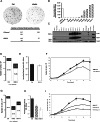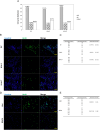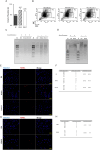KLHL14 is a tumor suppressor downregulated in undifferentiated thyroid cancer
- PMID: 38909024
- PMCID: PMC11193815
- DOI: 10.1038/s41420-024-02063-7
KLHL14 is a tumor suppressor downregulated in undifferentiated thyroid cancer
Abstract
KLHL14 is a substrate-binding subunit of Cullin-RING ligase 3 ubiquitin ligase complex, highly enriched in thyroid since early embryonic development, together with its antisense RNA KLHL14-AS. We have previously demonstrated that Klhl14-AS is a competing endogenous RNA regulating several differentiation and survival factors in thyroid cancer, acting as tumor suppressor. Recently, also KLHL14 has been shown to function as tumor suppressor in diffuse large B-cell lymphoma and in malignant mesothelioma. Here we show that KLHL14 expression is strongly reduced in anaplastic thyroid cancer, the less differentiated and most aggressive type of thyroid neoplasia. Such reduction is reproduced in different in vivo and in vitro models of thyroid cancer, being invariably associated with loss of differentiation. When Klhl14 expression is rescued in thyroid transformed cells, it reduces the cell proliferation rate and increase the number of apoptotic cells. On the other side, Klhl14 loss of function in normal thyroid cells affects the expression of several regulatory as well as functional thyroid markers. All these findings suggest that KLHL14 could be considered as a novel tumor suppressor in thyroid cancer, by also revealing its physiological role in the maintenance of a fully differentiated and functional thyroid phenotype.
© 2024. The Author(s).
Conflict of interest statement
The authors declare no competing interests.
Figures







Similar articles
-
A ceRNA Circuitry Involving the Long Noncoding RNA Klhl14-AS, Pax8, and Bcl2 Drives Thyroid Carcinogenesis.Cancer Res. 2019 Nov 15;79(22):5746-5757. doi: 10.1158/0008-5472.CAN-19-0039. Epub 2019 Sep 26. Cancer Res. 2019. PMID: 31558562
-
Characterization of KLHL14 anti-oncogenic action in malignant mesothelioma.Heliyon. 2024 Mar 9;10(6):e27731. doi: 10.1016/j.heliyon.2024.e27731. eCollection 2024 Mar 30. Heliyon. 2024. PMID: 38509883 Free PMC article.
-
Tissue- and Cell Type-Specific Expression of the Long Noncoding RNA Klhl14-AS in Mouse.Int J Genomics. 2017;2017:9769171. doi: 10.1155/2017/9769171. Epub 2017 Sep 10. Int J Genomics. 2017. PMID: 29082235 Free PMC article.
-
Molecular mechanisms of long non-coding RNAs in anaplastic thyroid cancer: a systematic review.Cancer Cell Int. 2020 Jul 29;20:352. doi: 10.1186/s12935-020-01439-w. eCollection 2020. Cancer Cell Int. 2020. PMID: 32760219 Free PMC article. Review.
-
Oncogenes and antioncogenes involved in human thyroid carcinogenesis.J Exp Clin Cancer Res. 1997 Sep;16(3):325-32. J Exp Clin Cancer Res. 1997. PMID: 9387909 Review.
Cited by
-
KLHL14 and E-Cadherin Nuclear Co-Expression as Predicting Factor of Nonfunctioning PitNET Invasiveness: Preliminary Study.J Clin Med. 2024 Jul 28;13(15):4409. doi: 10.3390/jcm13154409. J Clin Med. 2024. PMID: 39124679 Free PMC article.
References
Grants and funding
LinkOut - more resources
Full Text Sources
Research Materials

